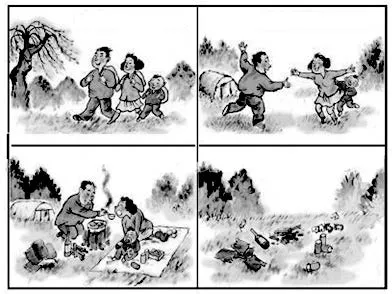系统复习,突出重点,重视语篇,提升技能
——非谓语动词的复习备考策略
2018-12-10河南
河南
众所周知,在高三复习备考阶段,应充分发挥教师的主导作用和考生的主体作用,在认真研读往年的高考试题,充分了解考试情况的基础上,教师应确定高考复习备考的深度和广度,为考生制定出缜密的复习方案。针对考生的难点和易错点,教师应及时采取解决方案,弄清考生出错的原因,帮助考生梳理知识,总结解题的规律和方法,做到重点突出、难点突破,从而提升考生的解题技巧和应试能力。
非谓语动词包括动名词(doing)、现在分词(doing)、过去分词(done)和动词不定式(to do)四个项目,而且,动名词、动词不定式和现在分词还有各种不同的形式,如一般式、进行式、完成式、被动式、完成被动式,由此可见这个考点内容繁多,用法复杂。请看非谓语动词考点的思维导图:

由于这个考点具备较高的区分度,所以一直颇受命题人的青睐。它既是历年高考必考的一个热点内容,又是考生容易出错的板块。下面笔者拟分析近年高考试题中非谓语动词考点分布和命题趋势,并探究其复习备考的有效策略。
一、近年高考语法填空题对非谓语动词的考查
研究近年的考点是确保复习备考成功的基础,教师应认真研究近五年高考试题,探究高考的命题规律和趋势,提出有效的备考方案,在复习备考中做到有的放矢。

近五年全国卷Ⅰ中的非谓语动词的考点分布:

近五年全国卷Ⅱ中的非谓语动词考点分布:

近三年全国卷Ⅲ中的非谓语动词考点分布:
从以上表格的统计数据可知,非谓语动词的六种功能全被考查过。其中,非谓语动词作宾语、作定语和作状语被反复考查,这些历年必考的内容就是高考的热点内容,也是备考的重中之重。
二、非谓语动词考点的重点突破
在复习备考时,教师应涵盖非谓语动词的六种基本用法,做到不遗漏任何考点。然后,针对考查的热点内容进行重点训练,做到重点突出、难点突破,确保考生遇到此类试题,能够从容应对,在这个考点上不失分。
(一)非谓语动词作宾语
只有动名词(doing)和动词不定式(to do)在句中可以充当宾语。在介词、某些动词和短语后,常接动名词,而另一些动词和短语后常接动词不定式。考生应熟练掌握这些高考必备的基础知识。
1.在介词、某些动词和短语后,常用动名词(doing)作宾语。表示主动意义用动名词的一般式(doing),表示被动意义用动名词的被动式(being done)。例如:
① We can improve our vocabulary by _______(read)English novels and magazines.(reading)
② My dad suggest me ________ (go) hiking on Sundays to build up my health.(going)
③ My cousin insisted on ________ (travel) to Tibet during the summer holiday.(traveling)
④ Maria wore dark glasses to avoid ________ (recognize)when she was shopping.(being recognized)
⑤ Surprisingly, John attended Martin’s birthday party without ________ (invite).(being invited)
【注意】后接动名词的动词和短语有:advise, admit,allow, avoid, appreciate, consider, delay, deny, dislike, discuss,enjoy, escape, excuse, fancy, finish, forbid, forgive, imagine,include, keep, mention, mind, miss, pardon, permit, practice,prevent, prohibit, report, risk, suggest, be busy(忙 于),be accustomed/get used to(对……习惯), be worth(值得),burst out(突 然 开 始),can’t stand(不 能 忍 受),can’t help(情不自禁),be devoted to(致力于),be opposed to(反对),contribute to(有助于,促成),decide on/upon(决定),feel like(想要),get down to(开始认真做),give up(放弃),insist on(坚持),keep on(继续),lead to(导致),object to(反对),put off(推迟),pay attention to(注意),set about(开始,着手),stick to(坚持),look forward to(期盼),keep/prevent/stop sb.from(阻止某人做某事)等。
2.在某些动词和短语后常接动词不定式作宾语。表示主动意义用动词不定式的一般式(to do), 表示被动意义用动词不定式的被动式(to be done)。例如:
① The manager of the company refused _______(make)any comments on the accident.(to make)
② Not having made careful preparations, Tom failed________ (pass) the driving test.(to pass)
③ I hope ________(admit) to a famous university when I graduate from high school.(to be admitted)
【注意】后接动词不定式的动词和短语有:afford,agree, aim, ask, arrange, attempt, choose, decide, decline,demand, desire, deserve, determine, expect, fail, guarantee,happen, hesitate, help, hope, learn, long, manage, offer, plan,prepare, pretend, promise, refuse, resolve, seek, tend, threaten,undertake, volunteer, wish, want, can’t wait(迫不及待),should/would like(想 要),would prefer(宁 愿),try one’s best(尽力),make an attempt(尝试), make a plan(计划),make a decision(决定),make a promise(承诺),make up one’s mind(下定决心),set out(着手),take action (采取行动),take one’s turns(轮流),take measures(采取措施)等。
(二)非谓语动词作定语
动名词、动词不定式、现在分词和过去分词均可作定语,但是它们的含义各不相同,教师应引导考生进行区别。
1.表示一个主动的、正在进行的动作常用现在分词的一般式(doing)作定语。单个的现在分词通常放在名词中心词之前,而现在分词短语通常放在名词中心词之后。表示正在进行的一个被动的动作则用现在分词的被动式(being done),通常放在名词中心词之后。例如:
① Early warnings of _______(rise) water levels prevented another major catastrophe.(rising)
② The girl _______(stand) at the school gate is Mary’s sister.(standing)
③ Food safety is one of the popular topics during the conference _______(hold) in Beijing these days.(being held)
【注意】现在分词的完成式(having done)通常不用作定语。
2.表示一个已完成的被动的动作常用过去分词(done)作定语。单个的过去分词通常放在名词中心词之前,而过去分词短语通常放在名词中心词之后。例如:
① It is a good habit to drink some cold ______(boil)water after getting up in the morning.(boiled)
② Most of the people _________(invite) to attend the meeting were famous scientists.(invited)
3.表示事物的用途或功能常用动名词(doing)作定语,通常放在名词中心词的前面。例如:
① A lot of people sat in the _____(wait) room, some of them talking quietly.(waiting)
② My grandma is able to move around with the help of a______(walk) stick.(walking)
4.动词不定式作定语时,常表示一个尚未发生的动作,通常放在名词或代词之后。如果表示一个主动的动作,多用动词不定式的一般式(to do);如果表示一个被动的动作,多用动词不定式的被动式(to be done)。例如:
① If you have someone______(talk) to, you will be cheerful.(to talk)
② I bet there are a lot of things ________(discuss) at the meeting tomorrow.(to be discussed)
(三)非谓语动词作状语
除了动名词不能用作状语之外,现在分词(doing)、过去分词(done)和动词不定式(to do)都可以作状语。它们的含义和用法均有所差异。
1.现在分词
现在分词作状语时,表示一个由主语发出的动作,可表示时间、原因、条件、结果、让步、方式、伴随状况和结果等。如果一个动作正在进行或与谓语动词同时进行,宜用现在分词的一般式(doing);如果该动作由主语发出,且早于谓语动词发生,宜用现在分词的完成式(having done);如果一个动作早于谓语动词发生,但主语是该动作的承受者,则用现在分词的完成被动式(having been done)。例如:
① _______(hear) the exciting news, they burst into tears.(Hearing)
② _______(suffer) from heart trouble for years, Professor White is now in hospital.(Having suffered)
③ _______(show) around the Water Cube, the tourists were then taken to the Bird’s Nest.(Having been shown)
2.过去分词
过去分词作状语时,表示一个被动的或已完成的动作或状态,可放在句首或句末,表示时间、原因、条件、结果、让步、方式、伴随状况等。例如:
① _______(attract) by the beauty of nature, we decided to spend another two days on the farm.(Attracted)
② _______(see)from a distance, the Sydney Opera House looks like the sails of ships.(Seen)
【注意】一些形容词化的过去分词作状语时, 并不表示被动,而表示主语的情绪或状态。例如:
① After his journey from abroad, Richard Jones returned home,________(exhaust).(exhausted)
② Jane sat there in silence, _______ (lose) in thought.(lost)
由“be+过去分词+介词”构成的短语通常表示主语的一种状态。去掉be后,直接用过去分词作状语。这些短语有:be worried about(对……担心),be lost in thought(陷入沉思),be addicted to(对……沉迷),be faced with(面临),be interested in(对……感兴趣),be absorbed in(专注于某事),be concerned about(对……关注),be pleased with(对……满意),be surprised at(对……感到吃惊),be satisfied with(对……满意),be armed with(武装着),be equipped with(装备有),be occupied in/with(忙于),be seated in/at(坐在……),be dressed in(穿着),be stuck in(被困在……),be located in(坐落于),be engaged in sth.(忙于某事),be caught in(被困 ,遭遇),be devoted to doing sth.(致力于做某事),be determined to do sth.(下定决心做某事)。
3.动词不定式
动词不定式作状语通常表示行为的原因、目的和结果等。如果表示主动意义用动词不定式的一般式(to do),表示被动意义用动词不定式的被动式(to be done)。
(1)表示目的。有时,为了强调,也可用in order (not)to do 和 so as (not) to do 结构(so as (not) to do 不可以置于句首)。例如:
① We work hard every day ______(get) good scores in the examination.(to get)
② Lucy shouted loudly and waved her hand in order________(notice) among the crowds.(to be noticed)
③ I’ll write down his telephone number so as not_______(forget) it.(to forget)
(2)表示结果。动词不定式常常表示意外的结果,可在其前加only或never。例如:
① Peter got to the station in a hurry, only _______(find)the train had gone.(to find)
② Tom and I went to the school library, only_______(tell)that it was under repair.(to be told)
③ Annie’s father disappeared ten years ago, never_______(hear) from again.(to be heard)
(3)在“主系表+动词不定式”结构中,动词不定式作状语,表示主语产生某种情绪的原因。例如:
① We are eager ______(cooperate) with your company.(to cooperate)
② I am delighted _______(receive) your greeting card.(to receive)
三、关注考生的易错点
根据笔者的教学经验,考生容易在状语从句的省略、独立主格结构、it作形式主语和宾语以及一些特殊句式中出现错误。在复习备考时,教师应特别关注这几个问题:
1.状语从句的省略
如果主句和从句的主语相同或从句的主语为it, 从句中含有be的某种形式,通常把状语从句中的主语和be动词省略, 保留“连词+现在分词/过去分词/形容词/副词/介词短语”。例如:
① When (it is) completed, the museum will be open to the public next year.
② While (I was) waiting for the bus to come, I bought a newspaper.
③ I am going to the seaside for my holiday if (it is) possible.
④ Children, when _________(accompany) by their parents,are allowed to enter the stadium.(accompanied)
⑤ Though __________(surprise) to see us,the professor gave us a warm welcome.(surprised)
⑥ While _________ (cross) the street, you can’t be too careful.(crossing)
2.独立主格结构
独立主格结构是由一个名词或代词,加上一个形容词、副词、介词短语、分词或动词不定式等构成的,在句中作状语。独立主格结构的逻辑主语与句子的主语不同,它独立存在。名词或代词与后面的形容词、副词、介词短语、分词、动词不定式等存在逻辑上的主谓关系。独立主格结构一般用逗号与主句分开,与主句之间不使用连接词。
(1)名词(代词)+现在分词(逻辑主语是分词动作的发出者)。例如:
① Weather _______(permit), the party will be held in the garden.(permitting)
(2)名词(代词)+过去分词(逻辑主语是分词动作的承受者)。例如:
① The problems ________(solve), the manager felt relieved.(solved)
(3)名词(代词)+现在分词的完成被动式(分词的动作早于谓语动词发生,且逻辑主语是该分词动作的承受者)。例如:
① The lecture _________(given), a lively question-andanswer session followed.(having been given)
(4)名词(代词)+动词不定式(动词不定式表示未发生的动作)。例如:
① So many people _______(help) us soon, we are sure to complete the task on time.(to help)
3.it作形式主语和形式宾语
如果作主语或定语的动词不定式或动名词短语过长,可用it作形式宾语和形式主语来代替它们。例如:
(1)it作形式主语
在“It + is/was +adj./n.(for sb./of sb.) + to do sth.”结构中,it代替动词不定式(短语)。如果形容词是表示事物的特点或特征的,如difficult,hard,easy,impossible,necessary,important等,应用介词for;如果形容词是表示人的性格特征或特点的,如nice,good,bad,kind,silly,foolish,wise,clever, careless,rude,brave,cruel,careful, grateful等,应用介词 of。例如:
① It’s important for us ______(have) a balanced diet every day.(to have)
② It is kind of you ______(offer) me timely help.(to offer)
但在“It is/was no use/good doing sth.”结构中 , it常代替动名词(短语)。例如:
① It is no good _______(argue) with Peter.He won’t listen.(arguing)
② It is no use ______(cry) over spilt milk.(crying)
(2)it作形式宾语
在“ 主 语 + think/find/feel/consider/make/regard...+ it +形容词/名词+to do sth.”结构中,it代替动词不定式短语。例如:
① I find it pleasant _____(work) with Jimmy.(to work)
② Mary makes it a habit ____(do) some reading in the evening.(to do)
但在“主语 + think/find/feel/consider/make/regard...+ it +形容词/名词+doing sth.”结构中,it代替动名词短语。例如:
① The professor considers it no use ______(read) without understanding.(reading)
② I think it no good _______(complain) without taking action.(complaining)
4.一些特殊句式
在一些特殊句式中,常用动词不定式或动名词短语。例如:
(1)常用动名词(短语)的句式:
① There is no point in getting upset.
② There’s no sense in blaming him.
③ There’s no point in worrying about it.
④There is no difficulty/trouble/problem (in) understanding the novel.
(2)常用动词不定式(短语)的句式:
① There is nothing to worry about.
② There is no need for us to praise it; it speaks for itself.
③ You need to get to the hospital—there’s no time to lose!
④ I have never wasted a chance to improve my English.
四、非谓语动词考点的备考策略
在高三复习备考阶段,考生们时间紧,而语法项目繁杂,导致复习任务重,怎么进行复习才能取得事半功倍的效果呢?
1.制作思维导图,帮助考生构建知识网络
借助于思维导图,教师可以清晰地呈现出某个知识块,从而帮助考生构建知识网络,提高考生的知识整合和迁移能力,在解题时快速、准确地获取相关信息。请看非谓语动词作状语的思维导图:

2.总结规律,化难为易
现在分词(doing)和过去分词(done)都可作表语和定语。但现在分词表示主动的含义,常用来描述事物,而过去分词表示被动的含义,常用来描述人。例如:
① The audience were deeply impressed by the ________(move) story.(moving)
② Jim was so ______(excite) that it was long before he calmed down.(excited)
③ The _______(excite) audience was talking about the movie loudly.(excited)
【注意】形容词化的现在分词有:amazing(令人惊异的),amusing(令人愉快的),annoying(令人生气的),boring(令人讨厌的),confusing(令人迷惑的),convincing(令人信服的),disappointing(令人失望的),disturbing(烦人的),embarrassing(令人尴尬的),encouraging(令人鼓舞的),entertaining(愉快的,有趣的),exhausting(令人精疲力竭的),fascinating(迷人的,有吸引力的),freezing(冰冻的,严寒的),frightening(令人害怕的),interesting(令人感兴趣的),moving(感动人的),puzzling(令人不解的),surprising(令人惊讶的),pleasing(令人高兴的),relaxing(轻松的),touching(令人感动的),worrying(令人担忧的),frustrating(令人失望的),tiring(令人疲劳的),thrilling(令人紧张的)。
【注意】形容词化的过去分词有:amazed(感到惊异的), amused(感到开心的),annoyed(生气的),bored(感到厌烦的),confused(感到迷惑的), convinced(相信的),disappointed(感到失望的),disturbed (受到干扰的),embarrassed(感到尴尬的),encouraged(受到鼓励的), entertained(感到愉快的),exhausted(精疲力竭的),fascinated(着迷的),frozen(冻僵了的),frightened(感到害怕的),interested(感兴趣的),moved(受感动的),pleased(感到高兴的),puzzled (感到不解的),relaxed(放松的,轻松的),surprised(感到惊讶的),thrilled(极为兴奋的),touched(受感动的),worried(感到担忧的),frustrated(感到失望的),tired(感到劳累、疲乏的)。
3.在语境中使用知识,把语法知识转化为语言技能
引导考生使用所学的语法规则来表达思想,在使用过程中把知识转化为技能。例如:


在课堂上,让考生用英语描述图画的内容和自己的想法,尽量使用非谓语动词形式。例如:
① It is no fun to play computer games.
② It is unwise for parents to lie to their children.
③ It is important for parents to set a good example to children.
④ A boy is busy sending text messages while having class.
⑤ Some students have formed the habit of playing with their smartphones.
⑥ We can see a boy sitting at the desk with his eyes staring at his smartphones.
⑦ The boy enjoys sending text messages instead of listening to his teacher in class.
在描述图画时,鼓励考生自由地表达思想,培养考生的发散思维能力,通过看图说话,使考生把语言知识转化为语言能力。
4.注重语篇训练, 在语境中提升语言技能
考生学习的语法知识离不开语篇,让考生在语篇中正确使用所学的知识是教师教学的最终目的。因此,在课堂上,教师应为考生提供大量的语境,让考生使用所学的语法结构自由地表达思想。
在英语课上,教师给出了下面一组图画,请考生用英语轮流发言,谈谈自己对这幅画的理解。并写出一篇100词左右的发言稿。

One possible version:
It was spring time.A family of three made a trip to the countryside.When they arrived at the foot of a hill, they saw the scenery was so beautiful that they decidedto put upa tent there.Then they played games on the grass,talking and laughing happily.When they weretired, they made a fire to have a picnic lunch.They went onplayingin the field that afternoon and had a good time.When night fell, they headed home,leaving a lot of rubbish behind, including packages,cans, soft drink bottles and plastic bags.
In my view, is wrongto pollute the environment.It is everyone’s responsibilityto protect the earth.Only in this way can we make the earth a better place.
总之,只要教师精确把握考点,明确目的,采取一些有效的复习备考策略,就能帮助考生系统地梳理知识,夯实基础,不断积累解题经验和技巧,最终提升应试能力。
